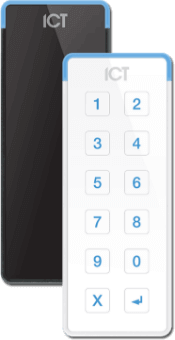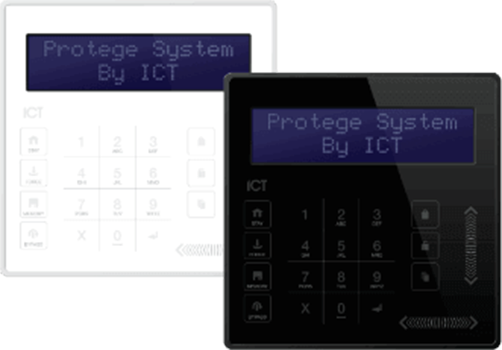Video MGMT System
 Access Control
Access Control
Voice & Data Wiring
 Burglar Alarm
Burglar Alarm
 Fire Alarm
Fire Alarm
Video MGMT System
Voice & Data Wiring
Too busy to read? Here’s a summary:
As technology continues to evolve, so does the need for more advanced and fool-proof access control. This article delves into the latest innovations in door access control, highlighting the technologies and trends shaping entry security into the future.
Access control refers to the selective restriction of access to a place or resource.
Traditional methods of access control, like keys and locks, have been around for centuries, but technological advancements have paved the way for sophisticated access systems that reliably reject bad actors and improve the experience of legitimate users.
In an age where speed and efficiency are paramount, RFID and NFC technologies have emerged as game-changers in the realm of access control.
RFID-based access control systems use electromagnetic fields to identify and read tags embedded in objects like smartcards automatically. These tags contain electronically stored information that can be read from a distance without a direct line of sight.
NFC is a subset of RFID that operates over a shorter range and provides superior data security. Rather than automatically transmitting identifying data to any reader that happens to be within range, NFC systems leverage encryption and two-way communication so that both the credential and the reader can authenticate each other before any sensitive data is transmitted.
This double authentication prevents unauthorized readers from cloning credentials, a risk with some RFID systems.
Advantages
Applications
These technologies are widely used in office buildings for employee access and in public transportation systems for ticketing. NFC (but not RFID) is also used for contactless payments.
The widespread adoption of smartphones has paved the way for their use as access control credentials. Mobile access transforms your phone into a digital key, eliminating the need for physical cards and fobs, let alone invasive biometric scans.
Through specialized apps or integrated systems, users can unlock doors or gates with just a tap on their smartphones.
Bluetooth: This wireless communication technology allows smartphones to communicate with access control door readers over short distances. Bluetooth-enabled access control systems can detect a user's smartphone as they approach, allowing for hands-free access control.
NFC: NFC allows two devices to communicate when brought closely together, typically fewer than a few centimeters. By tapping or bringing an NFC-enabled smartphone close to an NFC-enabled reader, users can initiate the process of gaining site access. In addition to mobile credentials, NFC data can be embedded in cards and other physical objects.
Wi-Fi: Some access control systems use Wi-Fi to communicate with smartphones, especially when remote access or management is required.
Applications
From office buildings to gated communities and even hotel rooms, mobile access is rapidly becoming the preferred method of entrance security.
Instead of electronic signal transmission, biometric systems use unique physical attributes—such as fingerprints, faces, and irises—to grant or deny access. These systems offer a high level of security because they rely on biological characteristics that are nearly impossible to replicate.
Advantages
Applications
Biometric systems are now commonplace in corporate offices, high-security zones, and even residential complexes.
Smart locks are electronic locking systems that can be operated remotely via a smartphone, wearable device, or voice command. They connect to devices using technologies like Bluetooth, Wi-Fi, or Zigbee.
Advantages
Applications
Smart locks are increasingly popular in residential settings, especially smart homes. They're also being adopted by hotels for guest room access and businesses for flexible workspace arrangements.
The landscape of security and access control is undergoing rapid transformation. Let's take a closer look at some pivotal advancements.
Instead of relying on on-site servers and hardware, cloud-based access control systems store data and manage access protocols on remote servers. Users can manage and monitor cloud-based access control systems from anywhere with an Internet connection.
Advantages
Applications
Businesses with multiple locations, manufacturing facilities, campuses, and residential complexes are rapidly transitioning to cloud-based access control.
The Internet of Things (IoT) refers to the network of physical objects or "things" embedded with sensors, software, and other technologies that enable them to connect over the Internet.
These embedded objects, or “things,” bring together items like refrigerators, thermostats, industrial tools, and, of course, security devices.
Thanks to IoT, unlocking a door can simultaneously turn on lights or adjust HVAC settings. In the event of an emergency, access control doors can automatically unlock to enable easy exits.
Advantages
Applications
Many modern office spaces leverage IoT to enhance site security and the user experience.
AI-powered predictive analytics in access control systems utilize machine learning algorithms to analyze vast amounts of historical data. By recognizing patterns and anomalies, these systems can predict potential security threats or breaches before they occur.
Advantages
This proactive approach allows organizations to address vulnerabilities and strengthen their security measures in real-time. It also offers insights into user behavior, helping to refine and tailor access protocols.
Applications
High-security zones, corporate offices, and even some smart homes are beginning to integrate AI-driven analytics to fortify their security infrastructure.
In an era when data breaches and hacking attempts are rampant, relying on a single form of verification is no longer sufficient for securing highly restricted areas.
Multi-factor authentication requires users to provide two or more verification methods to initiate the entry process. This combination of credentials can include knowledge (a password or PIN), objects (a card or token), and biological features (fingerprints, faces, or eyes).
Advantages
Even if one verification method is compromised, the intruder would still need to bypass the other layers of security.
Applications
From online banking platforms to secure data centers, multi-factor authentication is fast becoming a standard security protocol.
With the rapid evolution of technology, it's crucial for businesses and organizations to update their access control software regularly. Updates not only stay ahead of cyber threats, but they also help longtime users take advantage of new features and other improvements.
As threats become more sophisticated, so do the solutions designed to combat them. By keeping informed about the latest security trends and technologies, our team at Mammoth Security ensures that our customers stay ahead of the bad guys.
And we do a lot more than access control. Our crew knows the ins and outs of video surveillance, video management, intrusion detection, fire detection, and structured cabling for commercial-grade voice and data.
For a free site survey and consultation with a friendly expert from our team, just fill out the simple form below.
NOT COMPLETELY SURE?
860-748-4292Door access control is a security measure that regulates who can access a particular place or resource.
Smart locks allow users to unlock doors using devices like smartphones and wearables, often connected via Bluetooth or Wi-Fi.
Biometric systems use unique physical attributes, such as fingerprints or facial patterns, to grant or deny access.
The Internet of Things (IoT) is a network of devices connected through the Internet. It allows access control systems to integrate with other smart devices, creating a seamless and interconnected security approach.
AI-driven predictive analytics in access control can analyze data to predict potential security threats.
Multi-factor authentication bolsters security by requiring multiple verification formats, making unauthorized access more challenging.
Cloud-based solutions offer remote management, real-time updates, scalability, and reduced infrastructure costs.
While traditional keys are still in use (especially for home security), advanced solutions like smart locks and biometrics are becoming more prevalent in commercial-grade installations.
Integration allows for a holistic security approach, where one action, like a door unlock or a triggered fire alarm, can initiate other security protocols and device activations.